2012 Polaris 800 Switchback Review
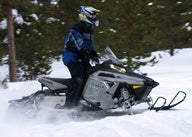
Base Switchback makes all the right compromises
Looking at its 2012 snowmobile product, it seems obvious that Polaris has its eye square on the sled sales prize. Last year’s powder-specific RMK series delivered sales leadership and prominence in the “what have you done for me lately” craziness that is the western snowmobile market.
Engine Type:Horizontal In-line
Cylinders:2
Engine Stroke:2-Stroke
Valve Configuration:Reed Valve
Displacement:795 / 48.5
Starter:Pull
Turbocharged:No
View Full SpecBefore the born-again Polaris RMK came the innovative Rush with its unique Pro-Ride rear suspension. Developed three seasons ago, the Pro-Ride Rush models evolved to a high level this season in the guise of the Pro-Ride Switchbacks. We’ve already told you that we think the top of the line 800 Switchback Pro-R should make everyone’s short list of “must have” sleds for this coming season. Heck, if it weren’t for the all-new Arctic Cat ProCross and ProClimb models, we might have given our blessing to the newest Switchbacks as “sled of the year.” It was a close call, though!
Keeping in mind that not everyone needs or wants to pay the US$700 premium for the exclusive to Polaris Walker Evans shock package and more aggressive Cobra track highlighting the 800 Switchback Pro-R model, the “base” 800 Switchback remains a very nifty piece of Polaris engineering. Much of what you get standard on the basic Switchback comes on the pricier Pro-R version. If don’t want to tinker with the shock settings every time you hit the trails, then the Walker Evans shocks may be excessive for you. The advantages of the slightly taller lug profile of the Cobra track will be lost to all but the most tuned-in rider. The grip difference between the 1.325-inch Cobra profile and the 1.25-inch RipSaw track lug height of the base Switchback is slight indeed.
What you will like comes standard on both versions. The key differences come in the end-user philosophy. The Pro-R models get the more “trick” pieces because Polaris marketing wants to set the two models apart, having the “R” to appeal to ego and riders who see themselves as attacking the trail, while the base model sets the standard for everyday riders who lean more to miles traveled. Don’t think for an instant that the non-R is vanilla.
The 2012 Polaris 800 Switchback comes standard with the Cleanfire-injected 800cc two-stroke twin that lights up the snow from idle to full throttle as soon as you ram the flipper to the bar. The 150-plus horsepower comes on quick and without hesitation. Polaris engineering refined the current Liberty twin over the past few seasons to make it the equal of any other two-stroke 800 on the snow. It is as tractable as the 120-plus horsepower 600cc, but has much more power on tap at virtually no weight gain.
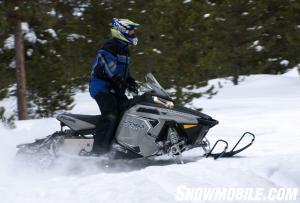 The 800cc Cleanfire twin plants power to the 136-inch RipSaw track.
The 800cc Cleanfire twin plants power to the 136-inch RipSaw track.
We’ll say it again. We used to favor the 600 twins because they gave us more dependable power at low to midrange engine speeds. The new 800 twins equal that capability, but offer a significant, but controlled, boost for top end. You can throttle down the new breed of 800s just as you can the 600s. But you can throttle up the 800s, unlike any 600 twins in the marketplace.
That’s also why we appreciate the extra length of the Switchback 136-inch track, regardless of lug profile. That added 15-inch length versus the standard trail performance Rush with 121-inch length track makes us more proficient riders. Slam the throttle and the new Switchback transfers back to the rear axle, putting power to a longer track patch, giving you improved grip, less track spin and more control than the shorter tracked Rush.
If you told us that the added length Pro-Ride 136 rear suspension worked better than the original Rush, we wouldn’t have believed you. We figured the power relay would be more lazy and the ride sloppy. Too soft. Not sporting.
Wrong! Stretching the Pro-Ride to fit into the revised Rush chassis that constitutes the 2012 Switchback works wonders at all levels. The sled turns into the corners consistently, where the previous Rush models wanted to fight you by lifting up the inside ski. As noted, the track grabs snow for smooth acceleration and under braking holds your intended line without slipping from side to side as much. In overall on trail ride, the added length provides the bridging effect expected of a longer track. Plus, the rearmost shock seems to react better to bumps and trail input than the short tracked suspension does. It all adds up to vastly improved ride and handling. Or, as Polaris puts it, a “wider sweet spot that requires less adjustment.” That’s why you don’t really need the Walker Evans shocks. The standard Fox gas shocks with the coil over spring work extremely well and have been tuned for a very nice compromise between high performance and daily ride.
Let’s not give all the applause to the stretched Pro-Ride. Polaris revamped the front end with a trick here and there that were learned on the racetrack. The “race” front suspension features newly tuned geometry that results in up to 20 percent easier steering effort with, more important, flatter cornering. Of course, some of that flatter cornering action comes from a revision in the rear suspension geometry and torque arm link to get a more supple action to the ski suspension. The double A-arm action is controlled with a coil spring over the Fox gas shocks. Travel action is up to 9-inches on the race-inspired front end and up to 14-inches on the rear Pro-Ride set up.
We also like the fact that the stretched out Pro-Ride suspension comes with a lengthened set of runningboards for improved off-trail movement and on trail comfort. The ‘boards feature large holes for evacuating snow and to minimize ice build up. You’ll note “fishbone” tunnel bracing to add structural rigidity. And you’ll feel the advantages of the redesigned “comfort” seat that offers a plush ride when sitting back in the middle, but a tapered cut as you move to the fuel tank. You’ll have room for a smooth trail ride as well as getting into action off-trail.
The new Switchbacks for 2012 represent the fact that Polaris “gets it.” These are sleds that show off some solid engineering and some serious snowmobiling know how. The keys are the 800 twin, the stretched Pro-Ride rear suspension and the updated A-arm front end. The nice to haves include the evolved Multi-Function gauge with the digital readouts that monitor speed, engine revs, engine temperature, and your trip miles and distance.
If there is a nit to pick, we’ll pick on the 800 Switchback color choice. The 800 comes in a gray, which is too pasty for our tastes, especially when the 600 Switchback gets decked out in a nifty “Sunset Red.” But, hey, that’s us. All in all, the 2012 800 Switchback, which should be readily available at dealerships this fall, is a very good sled with some suspension compromises that save you a few bucks versus the Pro-R edition. With that cash, you can opt for Polaris’ new Lock & Ride cargo system or other accessories to personalize your new Switchback. For us trail riding types, this is one of the best and most enjoyable sleds you can purchase for 2012.
| 2012 Polaris 800 Switchback Specs | |
| Engine | Polaris Liberty Cleanfire 795cc twin cylinder 2-stroke; liquid-cooled; Cleanfire fuel injection |
| Horsepower | 150-plus |
| Drive | Polaris P-85 drive; Team LWT Driven |
| Front Suspension | Polaris Pro-Ride (race-inspired & new for 2012); up to 9-in travel; Fox gas shocks with internal floating piston |
| Rear Suspension | Polaris Pro-Ride slide rail 136-in; Fox gas shock with internal floating piston on front and rear arm; 14-inch travel |
| Length | 115.0 in |
| Width | 48.0 in |
| Height | 46.0 in |
| Ski Stance | 42.5 in |
| Track | 15 x 136 x 1.25 RipSaw |
| Weight | 484 (claimed) |
| Brake | Polaris Phantom hydraulic disc |
| Fuel Capacity | 11.0 US Gal |
| Features | Electronic reverse (PERC); handlebar hook ends; multi-function digital display; electric start option; lock & ride optional luggage and rack |
| MSRP | US$11,299 |
Related Reading
2012 Polaris 800 Switchback Pro-R Review [Video]
2012 Polaris Switchback Adventure 600 Review [Video]
2012 Polaris 800 Pro-RMK Review [Video]
2011 Polaris 800 Rush Review



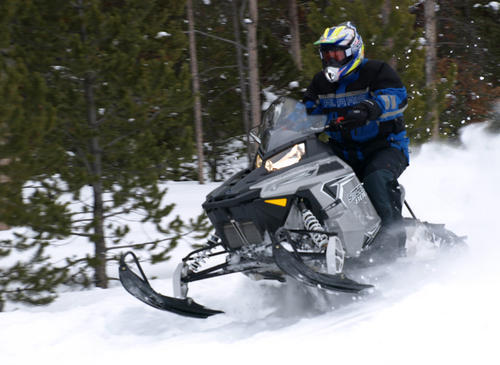
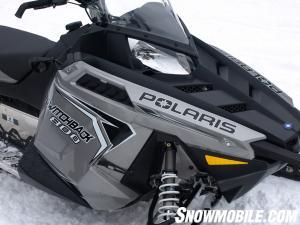
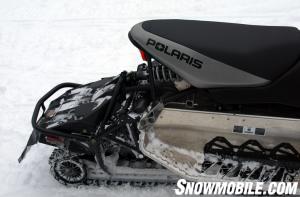
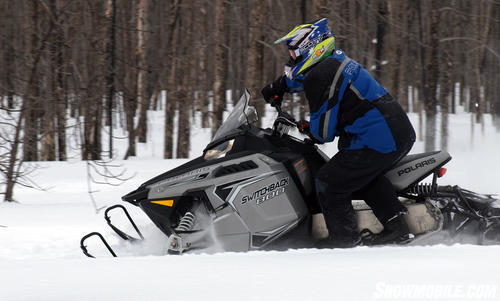
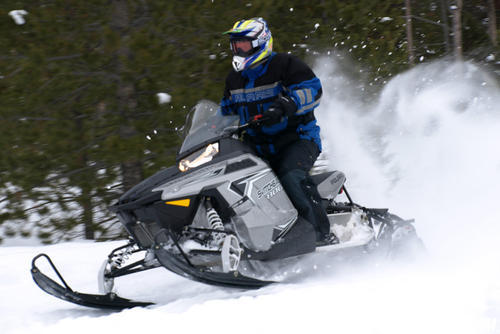

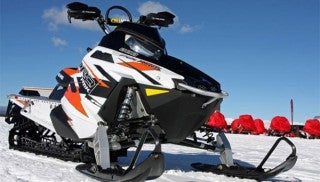
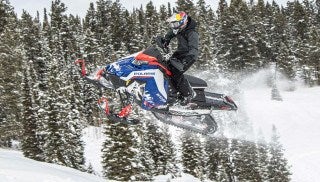


 Your Privacy Choices
Your Privacy Choices